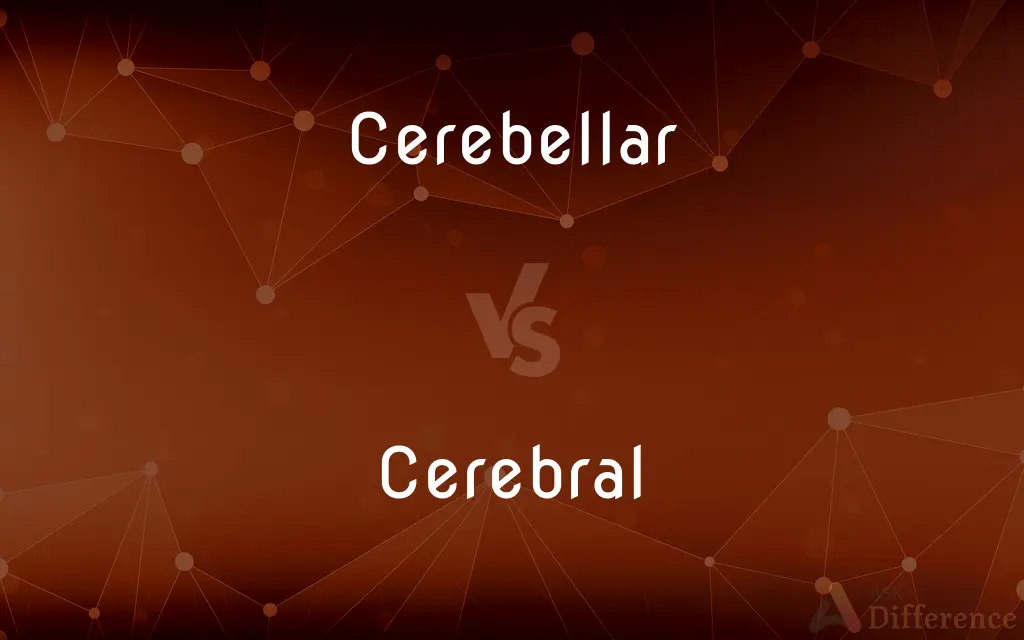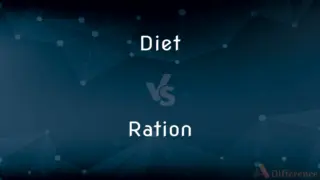Cerebellar vs. Cerebral — What's the Difference?
By Urooj Arif & Maham Liaqat — Updated on April 7, 2024
Cerebellar pertains to the cerebellum, involved in coordination, while cerebral relates to the cerebrum, responsible for cognitive functions.

Difference Between Cerebellar and Cerebral
Table of Contents
ADVERTISEMENT
Key Differences
Cerebellar refers to anything related to the cerebellum, a section of the brain at the back of the skull. Its primary role is to coordinate voluntary movements, maintain posture, balance, and speech. In contrast, cerebral pertains to the cerebrum, the largest part of the brain, encompassing functions related to thought processes, including reasoning, memory, speech, and muscle functions.
While the cerebellar function is crucial for motor control and coordination, ensuring smooth and balanced muscular activity, cerebral activities are centered around processing sensory information, and executing higher-level functions such as emotion, learning, and forming memories. The distinction highlights the cerebellum's role in physical coordination versus the cerebrum's role in cognitive abilities.
Disorders of cerebellar function can lead to ataxia, characterized by a lack of muscle control or coordination of voluntary movements, such as walking or picking up objects. Cerebral disorders, however, can manifest in a wide range of symptoms, from cognitive impairments, such as dementia, to emotional and psychological issues, showcasing the cerebrum's broader role in overall brain function.
The cerebellum communicates with other parts of the brain through pathways that allow it to influence movement and coordination. Meanwhile, the cerebrum's extensive network of neurons facilitates complex thought processes, making it the center of intelligence, interpretation of sensory data, and voluntary muscle activity.
Despite these differences, both cerebellar and cerebral functions are integral to daily life and interconnect to support overall brain activity. The balance and coordination provided by the cerebellum complement the sensory processing and thought generation of the cerebrum, illustrating the brain's complexity and the specialized roles of its different parts.
ADVERTISEMENT
Comparison Chart
Location
Back of the skull
Upper part of the skull
Main Function
Coordination of voluntary movements
Cognitive functions
Disorders
Ataxia, lack of muscle coordination
Dementia, cognitive impairments
Communication
With parts of the brain for movement
With entire brain for thought processes
Importance
Essential for balance and speech
Crucial for intelligence and sensory interpretation
Compare with Definitions
Cerebellar
Coordination focus.
Cerebellar activities ensure the smooth execution of physical movements.
Cerebral
Cognitive processes.
Cerebral functions encompass reasoning, memory, and emotion.
Cerebellar
Located at the brain's back.
The cerebellum's position at the back of the skull is strategic for balance.
Cerebral
Sensory information processing.
The cerebral cortex is key in interpreting touch, vision, and hearing.
Cerebellar
Movement and balance.
Cerebellar damage can lead to difficulties in maintaining posture.
Cerebral
Diverse disorders.
Cerebral impairments can range from learning disabilities to emotional disorders.
Cerebellar
Ataxia symptomatology.
Cerebellar disorders often manifest as ataxia, affecting movement coordination.
Cerebral
Upper skull location.
The cerebrum occupies the largest area of the brain, located in the upper skull.
Cerebellar
Speech regulation.
The cerebellum plays a role in controlling the pace and rhythm of speech.
Cerebral
Emotional and psychological.
The cerebrum's health impacts emotional well-being and personality.
Cerebellar
The trilobed structure of the brain, lying posterior to the pons and medulla oblongata and inferior to the occipital lobes of the cerebral hemispheres, that is responsible for the regulation and coordination of complex voluntary muscular movement as well as the maintenance of posture and balance.
Cerebral
Of the cerebrum of the brain
A cerebral haemorrhage
The cerebral cortex
Cerebellar
Of or pertaining to the cerebellum.
Cerebral
Another term for retroflex
Cerebellar
Of or pertaining to the cerebellum; as, the cerebellar artery.
Cerebral
Of or relating to the brain or cerebrum.
Cerebellar
Relating to or associated with the cerebellum;
Cerebellar artery
Cerebral
Appealing to or requiring the use of the intellect; intellectual rather than emotional
“His approach is cerebral, analytical, cautious” (Helen Dewar).
Cerebral
Of, or relating to the brain, cerebrum, or cerebral cortex.
Cerebral
Intellectual rather than emotional or physical.
Cerebral
Retroflex.
Cerebral
Of or pertaining to the cerebrum.
Cerebral
Involving intelligence rather than emotions or instinct;
A cerebral approach to the problem
Cerebral drama
Cerebral
Of or relating to the cerebrum or brain;
Cerebral hemisphere
Cerebral activity
Common Curiosities
What distinguishes cerebellar from cerebral functions?
Cerebellar functions involve coordination and balance, while cerebral functions are related to cognitive processes.
What role does the cerebrum play in sensory perception?
It processes and interprets sensory data from the environment.
Are cerebellar or cerebral disorders more impactful?
The impact depends on the disorder's nature and severity, affecting different aspects of life.
How do cerebral disorders manifest?
They can range from memory loss and impaired reasoning to emotional and psychological issues.
How do cerebellar and cerebral functions interact?
They interconnect to ensure smooth, coordinated physical movements and cognitive processing.
What advances have been made in treating cerebral disorders?
Advances include medications, therapies, and sometimes surgical interventions, tailored to specific disorders.
Can physical therapy help with cerebellar dysfunction?
Yes, it can improve coordination and balance issues associated with cerebellar dysfunction.
Can cerebellar disorders affect cognitive functions?
While primarily affecting coordination, cerebellar disorders can also impact cognitive functions indirectly.
Is the cerebellum involved in learning?
Yes, especially in motor learning and coordination tasks.
Can one live without a cerebellum?
Life is possible without a cerebellum, but with significant impairments in movement and coordination.
What is the importance of cerebellar-cerebral interaction?
This interaction is crucial for integrating motor control with cognitive functions, enhancing overall brain efficiency.
Can cerebellar damage be repaired?
While the brain has some plasticity, the extent of recovery from cerebellar damage varies.
What research is being done on cerebral health?
Research spans from neurodegenerative diseases to the impact of lifestyle on cognitive functions.
How do symptoms of cerebellar and cerebral disorders differ?
Cerebellar symptoms often involve physical coordination, while cerebral symptoms are more cognitive and emotional.
How does the cerebrum affect personality?
The cerebrum's frontal lobe is particularly important in determining personality and behavior.
Share Your Discovery

Previous Comparison
Thrash vs. Trash
Next Comparison
Diet vs. RationAuthor Spotlight
Written by
Urooj ArifUrooj is a skilled content writer at Ask Difference, known for her exceptional ability to simplify complex topics into engaging and informative content. With a passion for research and a flair for clear, concise writing, she consistently delivers articles that resonate with our diverse audience.
Co-written by
Maham Liaqat















































